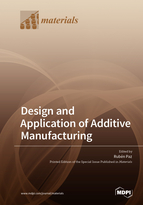Design and Application of Additive Manufacturing
A special issue of Materials (ISSN 1996-1944). This special issue belongs to the section "Manufacturing Processes and Systems".
Deadline for manuscript submissions: closed (10 April 2022) | Viewed by 31961
Special Issue Editor
Interests: manufacturing processes; additive manufacturing; design optimization; finite element analysis; biomaterials and natural fibre applications; additive manufacturing for tissue engineering applications
Special Issues, Collections and Topics in MDPI journals
Special Issue Information
Dear Colleagues,
Additive manufacturing (AM) is continuously improving and offering innovative alternatives to conventional manufacturing techniques. The advantages of AM (design freedom, reduction in material waste, low-cost prototyping, etc.) can be exploited in different sectors by replacing or complementing traditional manufacturing methods. For this to happen, the combination of design, materials and technology must be deeply analyzed for every specfic application. Despite the continuous progress of AM, there is still a need for further investigation in terms of design and applications to boost AM implementation in the manufacturing industry or even in other sectors where short and personalized series productions could be useful, such as the medical sector. This Special Issue aims to publish high-level research articles involving design and application of AM, including (but not limited to) innovative design approaches where AM is applied to improve conventional methods or currently used techniques, design and modeling methodologies for specific AM applications, design optimization (also driven by numerical methods such as finite element analysis) for pioneering uses of AM, and innovative design and applications of functionally graded additive manufacturing and 4D printing. The proposals must focus on the design apporach and application of AM, with the corresponding material and experimental characterization according to the specific application.
Prof. Dr. Rubén Paz
Guest Editor
Manuscript Submission Information
Manuscripts should be submitted online at www.mdpi.com by registering and logging in to this website. Once you are registered, click here to go to the submission form. Manuscripts can be submitted until the deadline. All submissions that pass pre-check are peer-reviewed. Accepted papers will be published continuously in the journal (as soon as accepted) and will be listed together on the special issue website. Research articles, review articles as well as short communications are invited. For planned papers, a title and short abstract (about 100 words) can be sent to the Editorial Office for announcement on this website.
Submitted manuscripts should not have been published previously, nor be under consideration for publication elsewhere (except conference proceedings papers). All manuscripts are thoroughly refereed through a single-blind peer-review process. A guide for authors and other relevant information for submission of manuscripts is available on the Instructions for Authors page. Materials is an international peer-reviewed open access semimonthly journal published by MDPI.
Please visit the Instructions for Authors page before submitting a manuscript. The Article Processing Charge (APC) for publication in this open access journal is 2600 CHF (Swiss Francs). Submitted papers should be well formatted and use good English. Authors may use MDPI's English editing service prior to publication or during author revisions.
Keywords
- additive manufacturing
- design
- innovative applications
- simulation
- optimization







